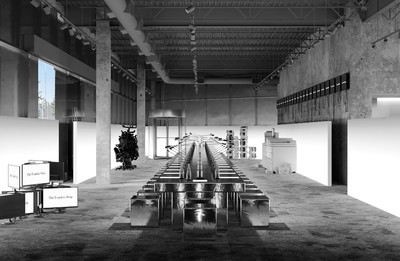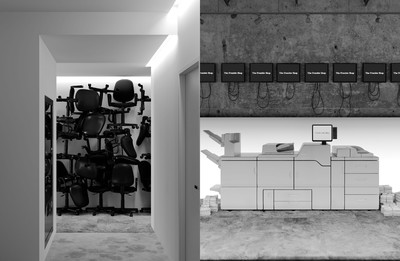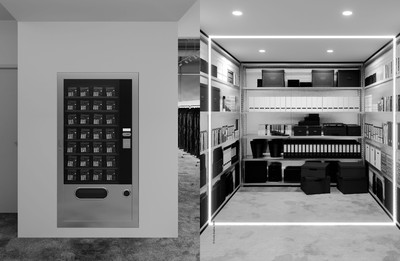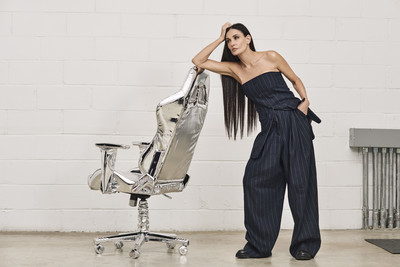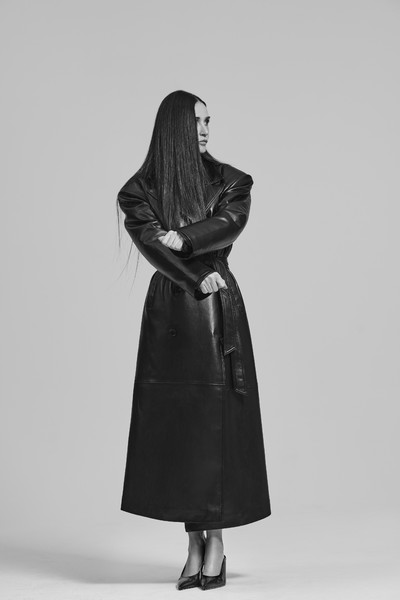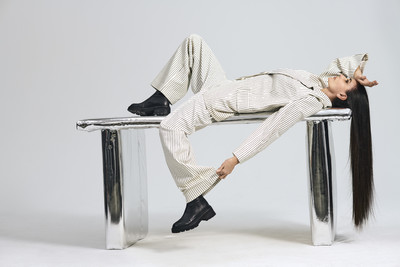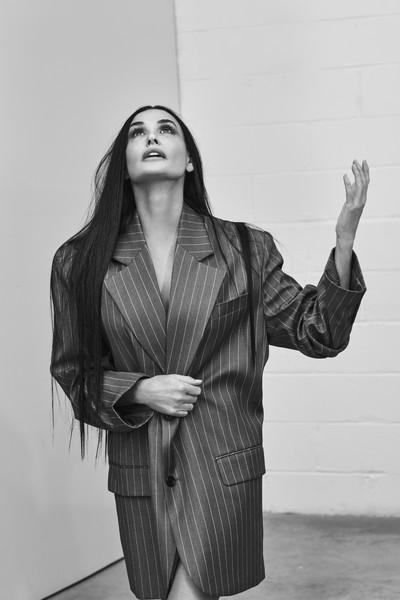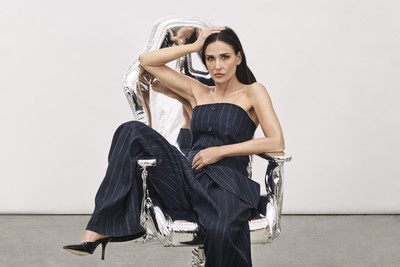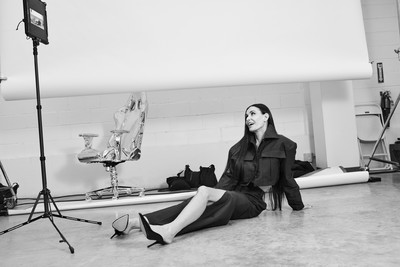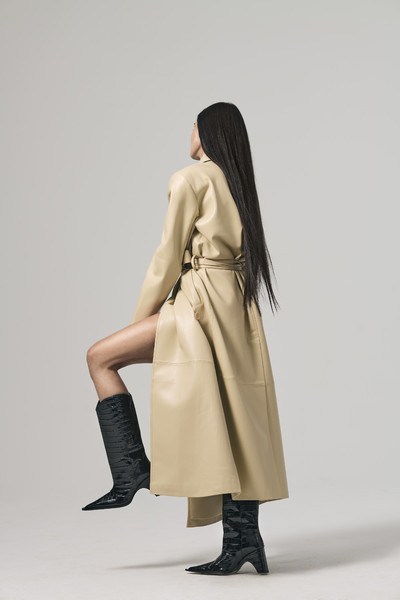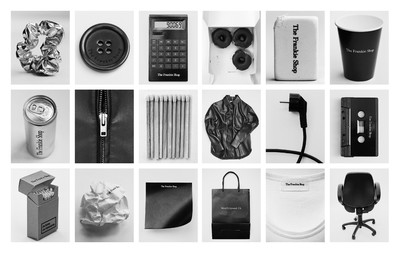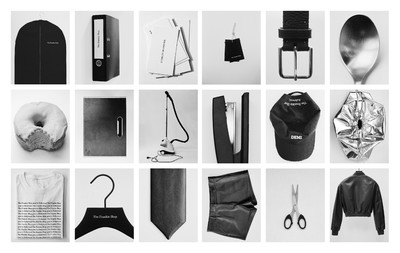The Frankie Shop
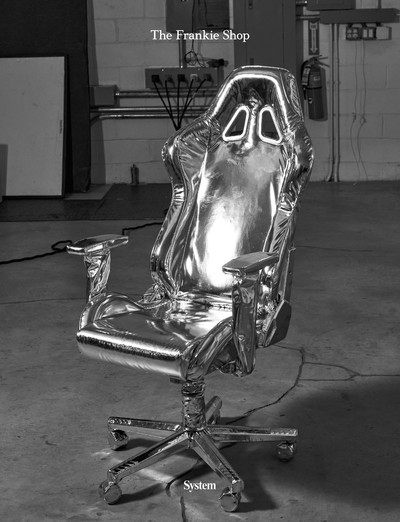
Every February, Los Angeles gears up to host the best of contemporary art from all over the world. At Frieze and throughout the city, galleries present works of artists grappling with the most relevant and urgent questions of our time. Among them this year is cult clothing brand The Frankie Shop whose founder Gaëlle Drevet has teamed up with artist, architect, and Crosby Studios founder Harry Nuriev; a key cultural figure known for his ability to imagine multiple futures while holding one creative vision.
Together, they’ve imagined and designed an installation-meets-pop-up store that fuses expression with commerce on the famed Sunset Boulevard in the heart of Hollywood. The exterior is covered in smooth reflective mirrors, hinting at the duo’s exceptional ability to prompt new perceptions, while the interior reflects a different reality: a workplace renaissance. Black branded water coolers line the walls, and metallic stools surround the sprawling minimalist meeting table that stretches across the room. All office equipment is sharp, elegant, and monochromatic – down to the staplers, cassettes, and calculators. ‘We tried to imagine what life beyond the office looks like,’ Gaëlle Drevet said of the pop-up, which opens alongside Frieze Los Angeles. ‘If you’re still working, how can you embrace a new environment?’
The willingness to reimagine the mundane comes as little surprise. For neither Drevet nor Nuriev conform to convention. On the contrary, their respective businesses are born from an irreverent spirit; one that breaks with the past to conjure up new aesthetics. For Drevet – whose brand has become synonymous with relaxed tailoring and oversized shirts – that means creating clothes for herself; for powerful women who want clothes that serve their high-powered lifestyle. Nuriev, meanwhile, has garnered a dedicated following for his intuitive and transformative approach to design; one that is characterised by innovation, simplicity, and clean lines.
The creative partnership between the two visionaries is built on a shared appreciation of essentialism as a mode of experimentation – and so, it’s no wonder that Nuriev is The Frankie Shop’s first artist collaborator. A look at the photographs by Collier Schorr of iconic actress and best selling author Demi Moore dressed in oversized trenches, draped across silver office chairs, only serves to affirm the collaboration. Demi represents ‘consistency, excellency and power,’ according to Nuriev – words that also apply to the project’s bold ambitions.
‘Any strength and power I may have comes from embracing all parts of myself, especially the parts I have held judgment against. The more I accept, honor, and celebrate my shadow side, the more empowered I feel, filled with gratitude, humility, compassion, and an enormous depth of love for myself, others, and life.’
Photographs by Collier Schorr
Styling by Masha Mandzuka
Hair stylist: DJ Quintero. Make-up artist: Kristofer Buckle.
Set designer: Javier Irigoyen. Set design assistants: Nick Kozmin, Colin Phelan. Stylist assistant: Rika Nurrahmah. Lighting designer: Ari Sadok. Digital tech: Jarrod Turner. Production: Sophie Tabet, Cecile Winckler. Post-production: Two Three Two Studio.
Special thanks: Carrie Gordon, Jemma Hinkly, Shea Spencer.
‘I like to disturb. I like to be a bit irreverent.’
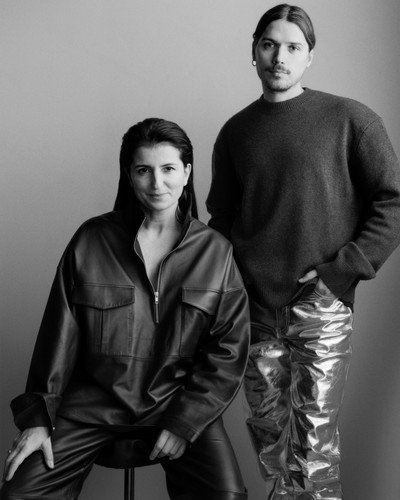
In an exclusive conversation between Drevet and Nuriev, the creative collaborators discuss elevated functionality, art versus commerce, and why irreverence is a driving force in both of their respective practices.
Rana Toofanian: Gaëlle, you founded The Frankie Shop in Paris in 2015. Can you share the story behind its inception?
Gaëlle Drevet: The Frankie Shop came about because I was trying to find a way to dress that was neither boring, contrived nor following the business attire codes. I was looking for certain silhouettes, and I just felt that there was a niche market I could cater to that didn’t already exist. The aim was to serve women like myself who are on the go. We don’t have a driver or a glam team. The clothes have to match the lifestyle of a powerful woman who wants to look like herself.
And Harry, can you share the backstory of how Crosby Studios was conceived? How would you describe your personal evolution as a designer – from architecture and interior to product, architecture and beyond?
Harry Nuriev: I was fascinated by fashion but I’ve never been a fashion designer. I actually feel very comfortable being a professional customer. But I get a lot of inspiration from fashion. And I think we, as Crosby, inspire a lot of fashion brands, too. I’d describe it as an intellectual conversation we have between two different industries. Back in 2014, I was in New York between Mercer Street and Crosby Street. That was the moment I had a strong feeling that it was time to start my own artistic practice. I didn’t know what exactly to do. I didn’t know where and how. But, I had a very strong feeling that – with regards to interiors, whether it’s a living room, a museum or a retail space – nothing was really exciting. Everything was either beige and vanilla, or it was classical. The smartest interior design style was Japanese minimalism, and then a few people had adopted what I would describe as a Bali-inspired style. That’s it. By contrast, how many fashion camps can you count? Countless. In New York, there’s 20 or 30. Everyday there’s a new fashion camp. So, I remember thinking: How do you express your personal style if you only express it through fashion, and not through your couch or your walls? People are like, ‘You can’t renovate every day’. But that’s bullshit. You do it once, you feel it, and you go again. Everyone hangs their jackets – from Rick Owens to Margiela and Armani – in the same closets all over the world. That’s why Crosby Studios started its journey.
Gaëlle: What’s funny is that we have a store on Crosby Street now. As if the stars are aligning.
Harry: What a street. For 10 years, I’ve tried to find something on Crosby. By the end, I was like: I should choose another street name for a company– it would be easier to find something.
‘The aim was to serve women like myself who are on the go. The clothes have to match the lifestyle of a powerful woman who wants to look like herself.’
Can you share the backstory behind how this collaboration between The Frankie Shop and Crosby Studios came about? Was this your first time working together?
Gaëlle: We didn’t know each other before. I’ve been following Harry and Crosby Studios for a while. I’m a big fan of design art – fashion is not just how you dress, it’s what you surround yourself with; your lifestyle. It’s all a curation of what you want people to see. So, I went to an event where Harry had designed a sofa in collaboration with Disney. We started talking on Instagram because that’s how conversation starts these days, and I was surprised that he sent me a message because, to me, he was like a Rockstar. He is super cool, edgy, and working with some of the best brands. I’m always thinking of myself as an outsider in that I never followed the regular path of a fashion brand. It was amazing to have someone like Harry who actually responded and who wanted to know more about The Frankie Shop. We met in this beautiful home in Saint Germain in Paris. By the way – it really wasn’t what you would expect from a regular Saint Germain home. When you step foot in that door you enter the world of Harry. The meeting should have been 30 minutes, but instead we were chatting for two hours. We ended up being late to everything else that day. It was a beautiful conversation.
Harry: It’s true, that’s how the collaboration started. From my end, one of my dearest friends, Vanessa Hong, always wore the most amazing outfits. I’d always ask, ‘What is this? What is this?’ And one day she showed me The Frankie Shop. That’s how I discovered the brand – and eventually, Vanessa even introduced us. When Gaëlle and I had that conversation, I don’t think either of us knew where we were going with it. We didn’t have a particular agenda or an idea of any partnership. In fact, the idea was born in this exact studio, and it escalated from there. From a simple installation to the projects we’re doing right now, I think this is a pure, rare example of [collaboration in’] the industry. So far, we’re super excited. Both of us have seen it as an exciting journey. And because we’re both stubborn, we don’t take no for an answer. So we make impossible things possible.
Gaëlle, what is it about Harry’s visual language and practice that you feel connected with your own design ethos? And Harry, what are the aspects of The Frankie Shop and its aesthetic that resonate with you in your own work?
Gaëlle: I’ve made a career out of elevating functional clothes. This is what I do. I try to combine allure with comfort. I think Harry’s approach to design is similar. It uses what is already there and makes it different through proportion, volume, texture. In that sense, I feel we work very well together and that we are very aligned with our approach to design. I like to disturb. I like to be a bit irreverent. I could have done just another pop-up, but that’s not what we wanted. Instead, our aim was to really bring something to the table, showing the world that it’s possible to combine installation and statement with selling clothes without making it commercial. There are so many ways of creating success – and taking the commercial road, the safe road, is not what we do.
Harry: I think we’re entering a new era of fashion and how we buy – what’s behind the decision of this or that purchase and what we do with it. For me, The Frankie Shop is at the forefront of this movement. I’m speaking from the perspective of a customer. I’m not a fashion critic or an official designer, I’m just sensing what’s good [and] what’s not. After 20 years of fashion that has explored silhouettes, colours, fabrics, and qualities and all these things. We’ve ended up in a world where sometimes we just want to look very nice. We want to say who we are without entertaining any extra layers of unnecessary things. That’s where The Frankie Shop fits in. And that’s also what was important for me. I’m the kind of customer that goes into a store and doesn’t want to celebrate anyone’s ego but mine. I want to have very functional things – that’s what’s important, and that’s what attracted me.
‘I’m the kind of customer that goes into a store and doesn’t want to celebrate anyone’s ego but mine. I want to have very functional things.’
How did the overall design and aesthetic concept for the collection and pop up materialise? And, jow did you select Los Angeles – and specifically the backdrop of Frieze – as the location for the pop up?
Harry: The location, the city, the country – that was all part of our conversation. We were thinking: Where should we do that? Where will it make the most sense? I don’t remember why LA was central to our conversation, but it was before Balenciaga did their show there. Before everything – when LA was far from both of us – we had a feeling that it’s important to do it there. The location itself was important: Sunset [Strip, Los Angeles], the whole story after a meal; the references of offices that are empty. We tried to imagine what life beyond the office looks like. If you’re still working, how can you embrace a new environment? We’re both hard workers; we’re both really passionate about what we do; and we’re both running companies. We had the freedom to choose everything together [for this collaboration] because there was no brief. It was just a blank canvas from the beginning, which rarely
happens.
Gaëlle: Frankie has never really done that many collaborations. I could have done a collaboration with another fashion designer, but unless you combine two very different aesthetics – like traditional clothing with what we do now – I don’t find it interesting. I just don’t believe in doing things if you’re not bringing anything to the table. To me, it was so interesting to be able to do our first collaboration with a true artist and connect the dots with something that was outside the fashion circus; something that would bring attention to clothes in another environment beyond fashion because, once again, this is about keeping what we wear every day modern and interesting. LA is obviously a big market for us. It’s where we have a lot of customers. So, it was really a no-brainer, especially with Frieze and the connection to art. What do you think, Harry?
Harry: Yes, my goal was to take the fashion world outside of its comfort zone; somewhere they’re not necessarily super familiar or important. That was the simple idea. Because again, as Gaëlle said, we don’t do things that don’t also serve a traditional function. We’re always thinking, what else can we do?
I want to get into some of the specific design qualities of the installation. Harry, Your designs often feature, as Gaëlle mentioned earlier, unexpected materials and unconventional combinations. Can you tell us a little bit about your philosophy regarding materials and how they were selected for this project?
Harry: I like pretty things and I work with materials every day, but it’s also not as important to me as most people might think. I don’t think about materials and colours as much as I think about the overall philosophy of the project. Materials can evolve and then absorb context or they can stand against context – either way, it’s not that important. What is important to me is defining the powerful woman and how she handles herself. What does she do first thing in the morning? This collaboration is about women who don’t take any orders and who feel very confident in their skin. This was at the top of the pyramid, and then we decided that the colours and materials should be conservative as long as they can be interpreted in different ways. For instance, we don’t use light in the traditional sense. We haven’t installed lights in the ceiling – we lit the walls. That way, it’s all about the conference room; it’s all about this reunion where ideas are brought to the table, and each of them is important. There’s microphones on the conference table that symbolise the voice and the expression of ideas – because when people listen and want to know, they want to hear what you say. For me, the most important aspect was the stack of office chairs as a representation of the post office era. What’s happening a minute before movers are coming to clean the office of all this old furniture? What decisions will we make at this table? How will your business fit in the New World Order? These are the kinds of questions we are asking. The designs ended up being very black and white, very contrasted. We’ve played with high and low where ugly designs are turned into pretty objects and pretty objects are hidden as, for example, a coffee machine in the background. We’re repurposing what typically exists [in an office].
Gaëlle: Yes, think of old cafeterias and meeting rooms where people gathered by the coffee maker, vending machine, and water cooler.
Harry: They represent the old office era. But they also become representative of how miserable office life and office design can be when it comes to the most important things: the water, the document folders. These are the layers of interpretation we are going to bring to Frieze, and that we will try to talk about with our community.
And what about the goodies collection? It includes items that are part of the office experience, like the stapler and the pens, as well as the baseball caps with the celebrity names.
Gaëlle: The caps are for the Hollywood nut, but they’re not really connected to the installation per se. I always wanted to use the phrase, Frankie Goes to Hollywood.
With regards to the installation, Harry has a 360 vision. He’s thinking, ‘From the moment you walk into this office space, what do you use? The stapler or the calculator? The notepads, the coffee cups, or the doughnuts?’ It’s definitely a completed vision.
I love the exterior. It reflects back out, which I think is very LA. Right?
Gaëlle: For sure. We hope to create a lot of selfie moments in the mirror.
‘We had the freedom to choose everything together [for this collaboration] because there was no brief. It was just a blank canvas from the beginning.’
I’m sure you will. Gaëlle, when you spoke earlier, you said this was one of the first artist collaborations for the brand. And Harry, you also collaborate a lot with people in your practice. What role does collaboration play in your respective practices, and how do you adapt your approach to different contexts, cultures, and collaborators?
Harry: It’s an interesting question because I’m often asked about what it means to collaborate with brands and how I choose the brands I collaborate with. People are very fascinated by this, but to me brands are not just brands. They are the people behind them. And these people can be very different from the overall touch and feel of the brand itself. Even big corporate companies that have huge offices are made up of people with names who work in them – and that’s what excites me. They come to me with issues or problems they want solved. That’s why I love my job. It exists outside of service, outside of marketing strategy, and outside of fashion weeks. I also have gratitude because I was always inspired by fashion and I think I manifested it into my life. Even though fashion [as an industry] can be very annoying to work in.
Gaëlle, how does this collaboration and pop up experience in LA tie in with your brand’s overall mission and vision?
Gaëlle: This collaboration is very much a reflection of how I’ve never followed the usual path of a fashion brand. Even the word fashion is all about clothes. Obviously that’s what fashion is, but like I said it’s also very much an environment for me; it’s about confidence and how you express this confidence; it’s about how you want to look today.
I’ve never thought about commercial success. I’ve always followed what I thought was right for Frankie. Though I think this pop up will be a commercial success, it’s not the end goal. The point is to express ideas in ways that are different, and show that you can disturb the fashion world with an installation that sparks dialogue. We’ve always been a little irreverent. I never put commercial shoots on my Instagram – it’s very much for people and I share what people wear. That’s what I do; this is how we function. It’s not about us. Frankie belongs to everybody that wears it. And this is why it was successful. I don’t want to be everywhere, I want to remain a niche market, but with global relevance.
My last question for both of you: when you make a project, you’re thinking about what people take away from it, but you’re also working outside of people’s reactions. What do you hope people come away with from this experience?
Gaëlle: It’s funny you ask this question because Harry mentioned earlier, ‘I just want to tattoo this image in people’s heads.’ I thought this was so amazing because we always think about the exterior. Tattoos are an exterior sign. I am very much aligned with what Harry said: I’d like to tattoo these images into people’s heads. I want them to step out of their boundaries with this project and think about fashion as a universe; about how you carry yourself in the world today and how you handle yourself today.
Harry: Even our talent, Demi [Moore], is part of this art installation whether she knows it or not. She represents consistency, excellency and power – all of which fit the project perfectly. For me, she is a Frankie Shop. And she suits Frieze in LA because she’s an iconic Hollywood actress. That’s what made this project perfect. Walls are brands and chairs have people behind them, and we want to know who these people are. That’s what is important.
Gaëlle: And remember, Demi broke barriers in Hollywood, she was the highest paid actress for hers films at that time. She shaved her head. She posed naked pregnant on the cover of Vanity Fair. She’s made a lot of bold moves as a woman. In Hollywood, you have to be very business minded to get the part. If you love acting, much of your job can become business strategy.She did things that were really out of the ordinary for an actress – she took herself and her character out of her comfort zone.
System
Editorial Direction: Rana Toofanian
Editor: Daphne Chouliaraki Milner
Transcription: Thomus DaCosta
The Frankie Shop
Founder and Creative Director: Gaëlle Drevet
Art Direction: Clarice Fensterseifer
Special Thanks
Unemployed Agency
Sophie Tabet, Cecile Winckler
